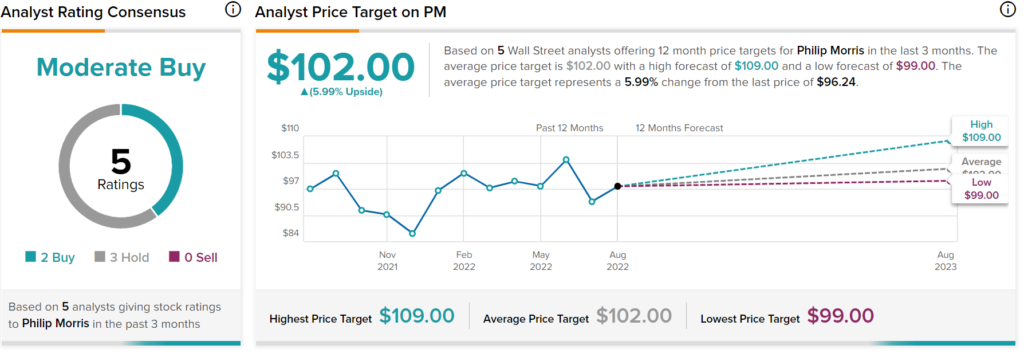Phillip Morris’ (PM) resilient business model once again demonstrated its ability to generate strong results, powered by an inelastic product category with stable demand characteristics and incredible pricing power.
Don't Miss our Black Friday Offers:
- Unlock your investing potential with TipRanks Premium - Now At 40% OFF!
- Make smarter investments with weekly expert stock picks from the Smart Investor Newsletter
Nevertheless, with the entirety of Philip Morris’ cash flows coming from outside the United States, the company’s vast international exposure is inherently bound to several of the underlying macroeconomic and geopolitical risks currently shaking the markets.
The two most significant issues the company is currently facing are the ongoing invasion of Ukraine, which has disrupted operations in the relevant regions, as well as the strengthening dollar. Since all cash flows are sourced from currencies other than the dollar, the company is facing heavy FX headwinds, further pressuring its top and bottom line metrics.
As a result, I am neutral on the stock.
Philip Morris Reported Strong Q2 Numbers When Put into Context
At first glance, Philip Morris’ Q2 results appear somewhat weak. However, when put into context, one can see why the company delivered another excellent quarter considering the circumstances. In its Q2 results, Philip Morris posted net revenues of $7.83 billion, 3.1% higher than the comparable period last year. In addition, while shipment volume rose by just 1.1% collectively, on a Pro-forma basis, growth was actually 3.0%.
By Pro-forma, the company basically excludes its Russia and Ukraine-related sales to provide a fair year-over-year assessment amid the ongoing war.
Total shipment volume growth was derived by cigarette shipment volume increasing by 2.4% and heated tobacco shipment volume increasing by 7.4%. These numbers need some additional context, however. In particular, as was expected back in April, heated tobacco unit shipment volume during Q2 was adversely affected by the timing of shipments to Japan.
Specifically, we are talking about roughly 2 billion units, which are expected to be landed in the second half of the year as the company handles the cancellation of scheduled heated tobacco unit manufacturing in Russia. The ongoing global logistical bottlenecks were another negative contributor to this as well. However, in-market sales for heated tobacco units actually rose by 19.9% in Q2 on a pro forma basis, even suggesting an acceleration from Q1.
It’s interesting to see cigarette shipment volumes increase amid a smoking population that’s in decline. Therefore, it should comfort investors to know that normal cigarette consumption is actually not descending as fast as many suppose. This also highlights how resilient this product category continues to be.
As mentioned, the company is also currently being impacted by strong FX headwinds since all of its cash flows are derived from outside the U.S. Yet, Pro-forma earnings-per-share in constant currency rose 5.6% year-over-year. This further illustrates the company’s ability to retain strong margins in a highly inflationary environment, as the demand for tobacco products is highly inelastic.
Overall, it’s very important to stress that the company’s performance, excluding the ongoing war and currency headwinds, remains as resilient as ever. So much so that management actually boosted its Fiscal Year 2022 outlook, now forecasting constant-currency Pro-forma earnings-per-share to be in a range of $6.09 to $6.20. This implies growth in the range of 10% and 12% from last year’s figure of $5.53.
PM Stock’s Dividend isn’t Going Anywhere
Philip Morris’ dividend is a fundamental component of its investment case and a major reason why investors remain committed to the stock despite its anti-ESG nature. Thus, ensuring its coverage is of critical importance to the company. With results remaining robust on a Pro-forma basis, investors should have nothing to fear regarding any unfortunate scenario.
In fact, during the post-earnings conference call, management mentioned its commitment to its progressive dividend policy is unwavering and that they are looking forward to the additional cash flow the proposed acquisition of Swedish Match would bring.

While the rate of dividend hikes has slowed down lately, with the most recent dividend-per-share increase at 4.2%, the 5.2% yield should be enough to please income-oriented investors. With four $1.25 dividends already declared, investors should be celebrating another dividend hike as shortly as around mid-September.
Additionally, with the increase in cigarette shipment volumes, strong pricing, and a more satisfactory margin mix, the dividend payout ratio should improve moving forward.
Furthermore, as heated tobacco sales become a larger percentage of total revenue, profit margins continue to expand. For context, in Fiscal Year 2021, Philip Morris’ adjusted operating income margin expanded from 29.6% to 33.2%.
Based on the midpoint of management’s Pro-forma earnings-per-share outlook for this year, the payout ratio stands at 81.3%. Thus, dividend growth in the mid-single-digits should be somewhat reasonably supported moving forward.
Is PM Stock a Buy or Sell?
Turning to Wall Street, Philip Morris has a Moderate Buy consensus rating, based on two Buys and three Holds assigned in the past three months. At $102, the average Philip Morris stock forecast implies 6% upside potential.

Takeaway – Philip Morris is a Resilient Business for Tough Times
In today’s tough market environment, investors can rely on Philip Morris to keep producing resilient profits. Although the business is currently being impacted by various macroeconomic and geopolitical issues, its performance should remain robust due to the nature of its products.
As heated tobacco products gradually position the company for a smoke-free future, margins should keep expanding, continuing to support Philip Morris’s legendary dividend growth track record. At a forward P/E of 17.2X, the stock is not notably cheap. Nevertheless, the durability of its business model does deserve the multiple in the current environment.



















